Understanding Different Types of Cybersecurity

As technology becomes increasingly embedded in business operations, organisations face heightened exposure to a variety of cyber threats, such as unauthorised access and malicious attacks. Cybercriminals are evolving their tactics and exploiting vulnerabilities, prompting businesses to prioritise robust cybersecurity. In this article, we’ll explore different types of cybersecurity and the latest trends shaping the industry in 2024.
Types of Cybersecurity
1. Network Security
Network security serves as the bedrock of a dependable cybersecurity strategy, emphasising the protection of data integrity, confidentiality, and availability across networks. Key components of network security solutions include firewalls, intrusion detection and prevention systems (IDS/IPS), and virtual private networks (VPNs). These cybersecurity solutions join hands to monitor network traffic, block unauthorised access, and keep secure communications. For instance, an organisation may deploy VPNs to encrypt data transmitted over the network for secured communications.
2. Endpoint Security
Endpoint security is concerned with protecting individual devices such as computers, smartphones, tablets, and servers from cyber threats. This type of cybersecurity involves installing antivirus software, employing endpoint detection and response (EDR) solutions, implementing data encryption, and enforcing access controls. Endpoint protection technologies help businesses prevent cybercriminals from hacking devices for unauthorised access to their networks.
3. Cloud Security
Cloud computing has emerged as an essential technology for modern businesses. It plays a part in offering flexible, scalable, and cost-effective data storage, management, and processing. Based on a report by Colorlib, about 94% of all companies worldwide are using cloud software, marking its significant value. Thanks to cloud services, businesses can now support their operations without the need for extensive physical infrastructure.
However, as businesses increasingly migrate to cloud environments, addressing the risks of data breaches and unauthorised access becomes a priority. Well-structured cloud security measures should always be in place to safeguard data, applications, and infrastructure hosted in the cloud. Some key practices include activating strong authentication mechanisms, encrypting data, and employing data loss prevention (DLP) strategies.
4. IoT Security
The Internet of Things (IoT) has revolutionised the way we interact with technology, ushering us to a connected world where daily objects can communicate, interact, and share data. Despite this remarkable evolution, IoT also introduces new security challenges. For example, the vast number of connected devices may provide more entry points for hackers. Therefore, the significance of IoT device security should not be underestimated. Implementing robust security controls and regularly updating firmware are crucial steps in mitigating the risks associated with IoT.
Top 3 Cybersecurity Trends Predicted for 2024
As we look ahead to 2024, several cybersecurity trends are set to transform how we approach digital security:
1. Increased Emphasis on AI and Machine Learning
Artificial Intelligence (AI) and Machine Learning (ML) are poised to play a pivotal role in cybersecurity. AI’s advanced data analysis capabilities are enhancing early detection systems to speed up the identification process and response to cyber threats. In 2024, AI-driven security bots are expected to focus on autonomous detection and neutralisation of cyber threats, steering towards more intelligent and proactive cybersecurity solutions. ML algorithms, on the other hand, are evolving to better recognise and address emerging threats.
2. Growing Significance of IoT Security
As the number of interconnected devices grows, so does the risk of widespread vulnerabilities. IoT security will become increasingly critical as businesses and individuals seek to protect their networks from attacks targeting these devices, maintaining the integrity of connected systems.
3. Expansion of Remote Work and Cybersecurity Impact
The rise of remote work has reshaped the professional landscape, making cybersecurity for remote access more important than ever. It is likely to see businesses place greater focus on securing remote work environments. Solutions like Splashtop may gain more popularity in fulfilling the security needs of this evolving work model.
By applying robust cybersecurity solutions that are tailored to your specific needs, you can shield your business from evolving cyber threats and maintain a secure digital environment.
At MyRepublic, we provide businesses in Singapore with advanced cybersecurity solutions to ensure comprehensive protection and keep you updated with the latest industry developments.



















